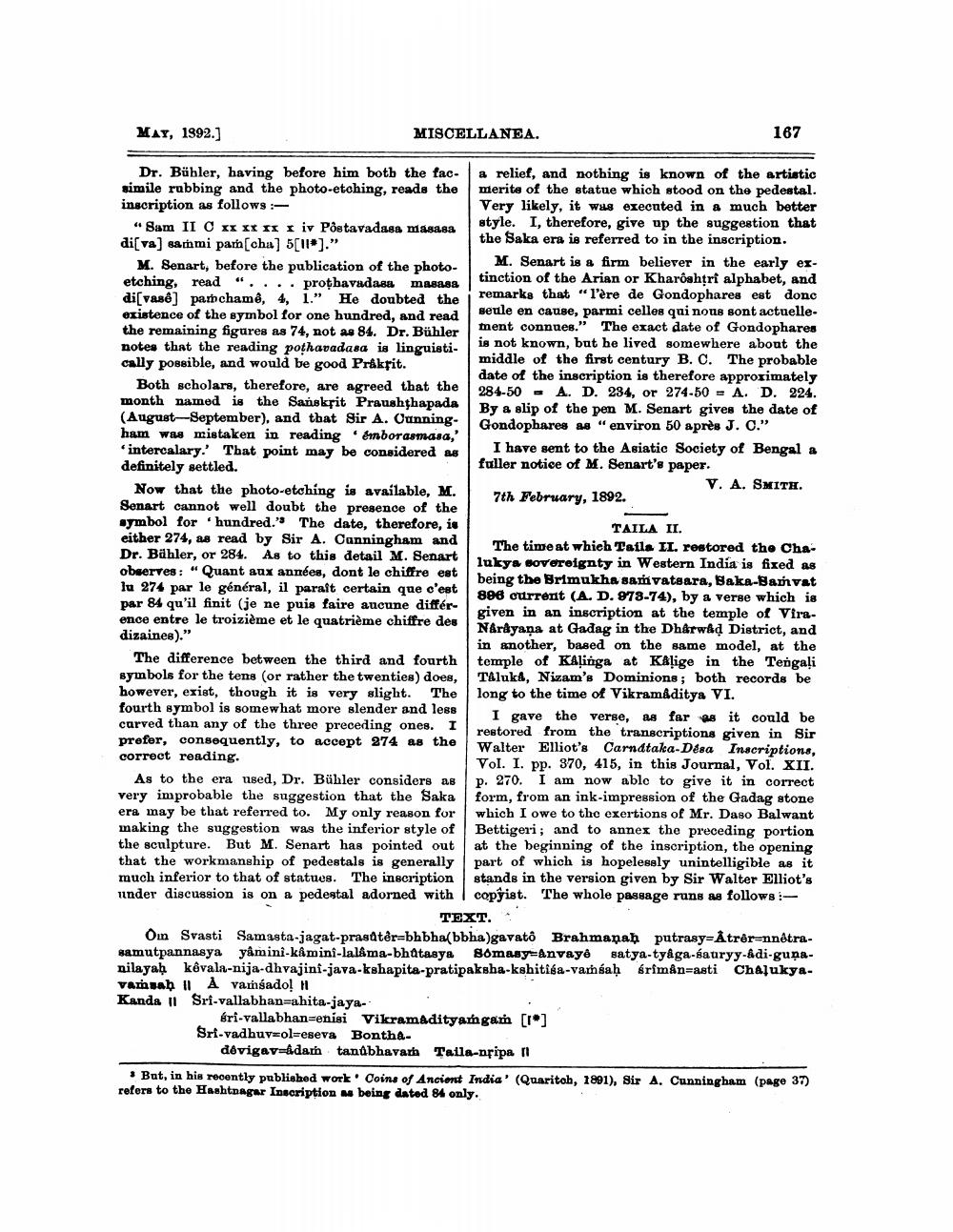________________
MAY, 1992.]
MISCELLANEA.
167
Dr. Bühler, having before him both the fac. a relief, and nothing is known of the artistic simile rubbing and the photo-etching, reads the merite of the statue which stood on the pedestal. inscription as follows :
Very likely, it was executed in a much better " Sam II C II IX II I iv Postavadasa masasa
style. I, therefore, give up the suggestion that diva) sammi pam(cha) 5[11]."
the Saka era is referred to in the inscription. M. Senart, before the publication of the photo
M. Senart is a firm believer in the early esetching, read ".... protbavadasa masasa
tinction of the Arian or Kharðahțrf alphabet, and di vasê] pamchame, 4, 1." He doubted the
remarks that "l'ère de Gondophares est donc existence of the symbol for one hundred, and read
seule en cause, parmi celles qui nous sont actuelle. the remaining figures as 74, not as 84. Dr. Bühler
ment connues." The exact date of Gondophares notes that the reading pothavadasa is linguisti
is not known, but he lived somewhere about the cally possible, and would be good Prakrit.
middle of the first century B. C. The probable
date of the inscription is therefore approximately Both scholars, therefore, are agreed that the
284-50 - A. D. 234, or 274.50 = A. D. 224. month named is the Sanskrit Praushthapada
By & slip of the pen M. Senart gives the date of (August-September), and that Sir A. Ounning
Gondophares as "environ 50 après J. C." ham was mistaken in reading Emborasmasa,' 'intercalary. That point may be considered as
I have sent to the Asiatic Society of Bengal a definitely settled.
fuller notice of M. Senart'e paper.
V. A. SMITH. Now that the photo-etching is available, M.
7th February, 1892. Senart cannot well doubt the presence of the symbol for hundred." The date, therefore, is
TAILA II. either 274, as read by Sir A. Canningham and
The time at which Tails II. restored the ChaDr. Bahler, or 284. As to this detail M. Senart
lukya sovereignty in Western India is fixed as observes: "Quant aux années, dont le chiffre est
being the Brimukha samvatsara, Baka-avat lu 274 par le général, il paraît certain que c'est
896 current (A. D. 978-74), by a verse which is par 84 qu'il finit (je ne puis faire aucune différ
given in an inscription at the temple of Viraence entre le troizième et le quatrième chiffre des dizaines)."
Narayana at Gadag in the Dh&rwad District, and
in another, based on the same model, at the The difference between the third and fourth temple of KAļinga at Kaļige in the Tengali symbols for the tens (or rather the twenties) does, TAluka, Nizam's Dominions ; both records be however, exist, though it is very slight. The long to the time of Vikramaditya VI. fourth symbol is somewhat more slender and less
I gave the verse, as far as it could be curved than any of the three preceding ones. I
restored from the transcriptions given in Sir prefer, consequently, to accept 274 as the
Walter Elliot's Carndtaka-Désa Inscriptions, correct reading.
Vol. I. pp. 370, 415, in this Journal, Vol. XII. As to the era used, Dr. Bühler considers as p. 270. I am now able to give it in correct very improbable the suggestion that the Saka form, from an ink-impression of the Gadag stone era may be that referred to. My only reason for which I owe to the exertions of Mr. Daso Balwant making the suggestion was the inferior style of Bettigeri; and to annex the preceding portion the sculpture. But M. Senart has pointed out at the beginning of the inscription, the opening that the workmanship of pedestals is generally part of which is hopelessly unintelligible as it much inferior to that of statues. The inscription stands in the version given by Sir Walter Elliot's under discussion is on a pedestal adorned with copyist. The whole passage runs as follows:
TEXT. Omn Svasti Samasta-jagat-prasatêr-bhbha(bbhagavató Brahmanah putrasy-Åtrêr=nnôtrasamutpannasya yåmini-kimini-lalama-bhatasya Somasy-Anvayê satya-tyaga-sauryy-&di-gunanilayah kêvala-nija-dhvajini-java-kshapita-pratipaksha-kshitiga-vamsah srimån=asti Chalukya. vamsah | A varsado! Kanda 11 Sri-vallabhanwahita-jaya
eri vallabhan=enisi Vikramadityanga. [1] Sri-vadhuvæol=eseva Bontha
dévigay-dam tandbhavaria Taila-nfipa |
* But, in his recently published work. Coins of Ancient India' (Quaritob, 1891), Sir A. Cunningham (page 37 refers to the Hashtagar Inscription being dated 84 only.




